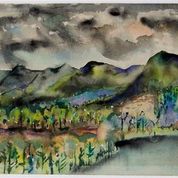

Joseph Fiore, Black Mountain Lake Eden, 1954, watercolor on paper, 13 ? × 18 inches. Asheville Art Museum. © Estate of Joseph Fiore / The Falcon Foundation.
February 15 – May 17, 2021 @ Asheville Art Museum
ASHEVILLE, N.C.— "Connecting Legacies: A First Look at the Dreier Black Mountain College Archive" features archival objects from the Theodore Dreier Sr. Document Collection presented alongside artworks from the Asheville Art Museum’s Black Mountain College Collection to explore the connections between artworks and ephemera. The exhibition is on view in the Asheville Art Museum’s Van Winkle Law Firm Gallery through May 17.
Archives are collections of records, such as letters, newspapers and photographs, also known as primary source materials. Museums often look to primary source materials for a variety of reasons: to add context to research about artworks, artists and the historical framework within which something was made.
Displayed in this exhibition are archival objects shown alongside works from the Museum’s Black Mountain College Collection, which is comprised of over 1,000 artworks and ephemera. These objects create connections, each one a thread contributing to a nuanced tapestry of the people, materials, geographies, and ideas of Black Mountain College and its ongoing legacy.
"Connecting Legacies"highlights ephemeral materials that focus on underrepresented narratives and the women and people of color of Black Mountain College. For instance, during the Summer Music Institute of 1944, almost 10 years to the day before the Brown vs. Board of Education Supreme Court Ruling, Alma Stone Williams became the first African American student invited to BMC. The following summer, musicians Roland Hayes and Carol Brice were welcomed to the College as its first African American Faculty. Programs from their performances are curated alongside student artworks made around the same period.
Black Mountain College was an experimental liberal arts community based in Black Mountain, N.C., from 1933 to 1957, founded by John Andrew Rice, Theodore Dreier, and others who believed in an educational model that was distinctly different from the prevailing frameworks of the time. Archival objects on view are part of the Theodore Dreier Sr. Document Collection and include mimeographs, letterpress, linoleum prints, offset prints, photographs, handwritten text, clippings, and correspondence. They contain internal records of the school and documentation from Dreier’s tenure at the school from 1933–1949, as well as correspondence, mailings, and publications through the mid-1950s.
Featured BMC faculty and student artists in this exhibition include Lorna Blaine Halper, Ruth Asawa, Hazel Larsen Archer, Elaine Schmitt Urbain, Warren “Pete” Jennerjahn, John Urbain, Joseph Fiore, Ray Johnson, Barbara Morgan, Anni Albers and more. Click on this line to view the exhibition on YouTube.
This exhibition encourages viewers to find connections running between artworks and items from the Theodore Dreier Sr. Document Collection, and invites the consideration of how the presence of primary sources impacts the experience of engaging with art.Connecting Legaciesis organized by the Asheville Art Museum and curated by lydia see, fall 2020 curatorial fellow, with support from a Digitizing Hidden Collections grant through the Council for Library and Information Resources.
Category: Exhibits